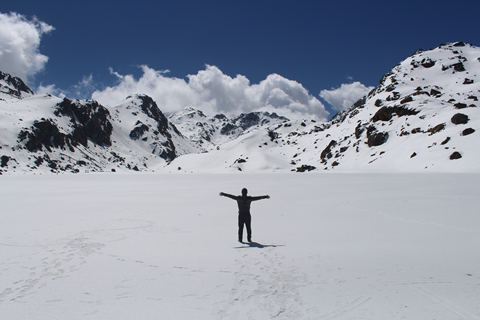We don’t see many cases of High Altitude Pulmonary Edema (HAPE) in the Wind Rivers, so last night’s case was a surprise. It was in many ways a classic scenario. The patient, a middle aged woman, started her backpack into the Winds two days ago and spent the first night at 10,200 and the second at 10,800. The route is hard work with an 11,000’ saddle the first day. On the second night she developed a persistent cough and a decreased ability to exercise; a fit athlete, she had trouble walking up easy hills. This is a textbook pattern.
When we first saw her, after hustling 8 miles up the trail, she was attempting to walk out of the mountains and descend, with painfully slow progress. At 9000’ she had wet lung sounds heard with a stethoscope (nothing audible), no wheezing and an elevated heart rate with marked reduction in ability to exercise. She didn’t look very sick with pink, warm and dry skin and normal mental status, but she was focused on her breathing, and described her lungs as tight and congested. She was coughing up some thick yellow stuff, breathing 20 times a minute and said her ribs hurt from all the coughing. She told us this was just like the HAPE she had experienced previously in the Andes.
In addition to the decreased ability to exercise, persistent dry cough, elevated heart and breathing rate, wet lung sounds and shortness of breath at rest, all on the sign and symptom list of HAPE, I looked for the pale or dusky skin and the frothy sputum we hear is associated with HAPE. I was thankful these late signs were absent.
We started her on the oxygen we carried with us, which really helped, even at only 4 l/m. She had less of a sense of air hunger, her coughing diminished and she could walk, albeit very slowly. With approaching darkness and marginal nearby landing zones we didn’t think the risk of a night extraction was warranted. This was one of those real risk versus benefit decisions we make in wilderness medicine. The plan was to move her a mile to place accessible by horse, and lower in elevation, and to have her ride. We walked slowly, and with some anxiety as exercise is not a good idea for someone with HAPE, but the oxygen was working wonders, while it lasted.
Treatment for HAPE is prompt descent and oxygen. In this terrain descent was slow, and we only managed 500’ between where we found her and where we staged for the horses. It wasn’t much, but we took all we could get. You’ll also see some medications, such as nifedipine and albuterol used as well, but these are not in my scope of practice as an EMT, and we didn’t have any available, nor did we have a portable hyperbaric chamber like a Gamow bag. I was impressed at how effective the oxygen was, and in the thirty minutes between the first tank running dry and fellow WMI staff Greg and Claire Fleming arriving in the dark with another tank the patient’s cough and sense of chest congestion returned and simple tasks like donning another clothing layer caused her to become short of breath.
We waited patiently under a cold and beautifully clear night sky. With the oxygen the patient was stable. Eventually the backcountry horsemen arrived with another 02 tank. The patient, an experienced rider, mounted one horse with the 02 slung on her shoulder and we set out the final 6 miles to the road head. The horses cruised, descending all the time, and we struggled to keep up to provide support if needed. I don’t think we looked very graceful pounding down the trail in the dark. The chest Xray in the hospital showed extensive diffuse edema, the patient was admitted and is doing quite well.
What impressed me the most was the impact of the oxygen, and those constants of wilderness medicine; how everything takes longer than planned, especially at dark, and how simple things like having enough layers, extra light sources, and the ability to be comfortable while we wait is so important.
If you’re interested in reading more about HAPE on the web:
An emedicine overview https://emedicine.medscape.com/article/300716-overview
The International Society for Mountain Medicine https://www.ismmed.org/np_altitude_tutorial.htm
Everest ER https://www.everester.org/
Himalayan Rescue Association https://www.himalayanrescue.org/hra/altitude_sickness.php#hape


